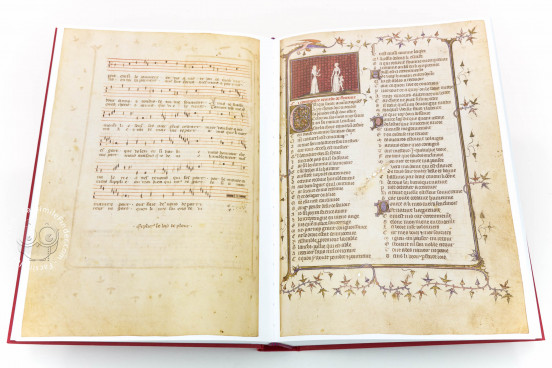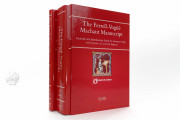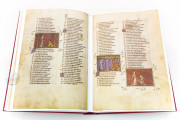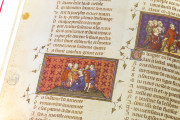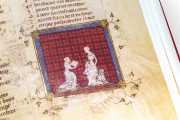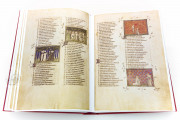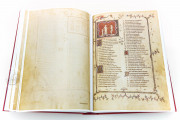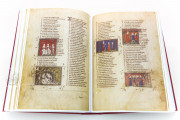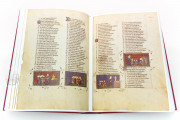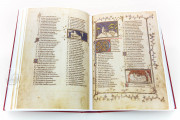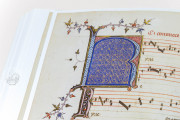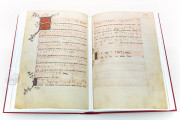The Ferrell-Vogüé Machaut manuscript captures the poetry and music of the most famous writer and composer of the fourteenth century, Guillaume de Machaut. Named for its current and past owners and made around 1369, it is the earliest manuscript of Machaut's works. It comprises the hundreds of pieces of music and poetry Machaut had composed by the time of its compilation. Probably made at Machaut's behest for presentation to John of France, Duke of Berry, it is a crowning glory of medieval illumination, justly famous for its 118 miniatures.
The Ferrell-Vogüé codex is the first in a series of "complete works" manuscripts of Machaut's oeuvre made under the author's supervision. Framed column miniatures elaborate the major works. Hundreds of decorated initials in colors and gold mark the beginning of separate pieces and passages.
Guillaume de Machaut and His Mass
The author of the manuscript's literary and musical works, Guillaume de Machaut (d. 1377), was a central figure in the musical style of the fourteenth century known as the ars nova ("new style"), highly influential in France and abroad.
Machaut's works are primarily secular, but his Messe de Notre Dame, the first surviving polyphonic setting of the Christian Mass Ordinary, is considered one of the masterpieces of fourteenth-century music. It makes its first manuscript appearance in the Ferrell-Vogüé manuscript (fols. 283v-296r).
Produced in the Circle of Charles V
The illumination of the Ferrell-Vogüé manuscript is in the style favored at the court of Charles V (1338-1380), King of France. The slender figures are rendered in graceful poses within minimal landscapes before diapered grounds, many featuring gold filigree. The poet-composer is pictured in the manuscript's first miniature as a tonsured cleric seated at his writing desk, with a music book open on its slanted surface (fol. 1r).
Orpheus as Sage
The manuscript offers a unique view of Orpheus, the classical Greek model of the poet-composer. Orpheus is once represented as a young, tonsured cleric (fols. 185v), equating him with the poem's author. He then appears as a youth (fol. 187r), in keeping with long artistic tradition, and finally as an older academic with a gray beard and scull cap (fol. 187v). In this last image, he holds an armillary sphere, a three-dimensional model of celestial bodies, portrayed as the learned teacher of the women who look on.
A Team of Nine Artists
The manuscript's many miniatures have been identified as the work of nine illuminators. The leader of this team was the Master of Jean de Sy (also known as the Boqueteaux Master), named for his work on a French-language Bible commissioned by Jean II (1319-1364), King of France (Paris, Bibliothèque nationale de France, MS fr. 15397). He also contributed to the illumination of the Savoy Hours at the behest of Charles V.
Six Scribes
Most of the text was written by two scribes, with smaller contributions by three more. The script is Gothic Textualis. The literary works without music notation are written in two columns, with the first letter of each line set off in the margin.
The notated pieces are arranged so the singers can see their parts with the book open in front of them. A sixth scribe, clearly an expert musician, wrote the mensural notation (giving precise pitch and duration of notes) on five-line staves and made a few additions and corrections to the text.
Looted by the Nazis
The manuscript was given by its original owner—John of France (1340-1416), Duke of Berry—to Gaston Phoebus (1331-1391), Count of Foix, who in turn lent it in 1389 to Violant de Bar (d. 1431), consort of John I, King of Aragon. The book remained at the court of Aragon until 1458.
Its whereabouts are next documented in 1875 when it was owned by Léonce-Louis-Melchior (1805-1877), Marquis de Vogüé. The manuscript was in the possession of the Parisian art dealer Georges Wildenstein (1892-1963) when the Nazis confiscated it in 1940. It was restituted to Wildenstein in 1949 and purchased by James E. and Elizabeth J. Ferrell in 1999.
We have 1 facsimile edition of the manuscript "Ferrell-Vogüé Machaut Manuscript": The Ferrell-Vogüé Machaut Manuscript facsimile edition, published by DIAMM, 2014
Request Info / Price
